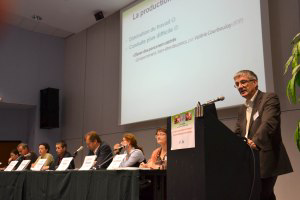French cracking their heads over imminent castration ban

Around 170 delegates from the pig production chain attended a conference in St Brieuc, France, in early October, on the imminent ban on castration in the European Union. The event, organised by the French Institute for the Pig and Pork Industry (IFIP), gave an overview of this topical issue for Europe’s pig industry.
By Philippe Caldier
As is well explained in many of the articles in this issue of Pig Progress, boar taint can prove to be a problem for Europe’s pig industry. Michel Bonneau, IFIP, pointed this out clearly when introducing the event, called Arrêt de la castration des porcelets en élevage – which translates as ‘A halt to castration of growing piglets’, saying that the hormones skatole and androstenone pose some serious problems for the swine industry. These are linked to the occurrence of boar taint – which occurs in certain cases if male pigs are not castrated.
Since a non-castration approach is what Europe is heading to, the question of how to avoid boar taint is a topical one – not only in France. In total, 278 publications have been made globally on the theme ‘boar taint’ between 2000 and 2012 – 40 of which are scientific publications in 2012. The majority of this research takes place in Europe, also Guelph, Ontario, Canada and Australia, zoom in on this issue.Several presentations emphasised the societal angle with regard to this issue. Laurence Bonafos, DG Sanco (European Commission), spoke about the ‘Declaration of Brussels’, adopted in December 2010 by stakeholders from the swine industry in the EU, to stop the surgical castration of pigs by 2018 – and to use anaesthesia or analgesia by 2012.For the French market, production of entire male pigs is opening a new way of differentiation, explained Patrick Chevillon, IFIP. Demand for entire male pigs, however, is not clearly expressed by the domestic market (consumers, distributors, butchers and processors). He said that a distinct market may come into existence for carcasses and cuts of females, castrated and non-castrated pigs. He said, “Entire male pig production will intensively develop in the North European countries by 2018 – uncertainties about acceptance of this meat will continue to exist in the other European countries.”
Alternatives
Valérie Courboulay, IFIP, focused on possible alternatives to castration. If chemical castration and semen sexing are not envisaged (the actual equipments can sort 14 million spermatozoids/hour while a dose counts 2 billion spermatozoids), two alternatives can be studied: Coverage of the pain and castration by vaccination.
The pain coverage can be done in three ways: General anaesthesia (used in Switzerland and the Netherlands), local anaesthesia and analgesia. Local anaesthesia is used in Norway since 2002, consisting of subcutaneous and intratesticle injections with a mix of lidocaine (2%) and adrenaline. This anesthesia is made by veterinarians, with a cost of €13.10/ litter.
Analgesia is a practice developing (in Germany, Denmark, France) on the initiative of Germany. Two products are available in France with an indication for castration: Melovem and Metacam (active principle is meloxicam). Courboulay said, “These products have been in use since January 2012 with an injection of 0.2 ml per piglet at an average weight of 2.5 kg.”
Immunovaccination is another possible alternative – for more on this topic, see Pig Progress issue 10 pages 20-21.
Producing entire males
Several presentations focused on how to produce meat from entire males. Courboulay did trials with entire pigs at the Romillé IFIP experimental station near Rennes, France. This experimental station has focused on non-castrated pigs since 2009 to actualise data on this topic. She said, “Entire males are more active than castrated animals.”
She observed that non-castrated pigs are more aggressive when fed rationed portions (both with dry and liquid feed). Aggressiveness seems linked to breeds – more negative behaviour were found with Duroc x Piétrain crossbreeds and more marked lesions were found with Piétrain boars.
In addition, the presence of females in the box has no effect on the pigs’ behaviour; more androsterone is produced following sexual excitement and more testosterone is produced following a case of aggression with a boar. Courboulay said, “Animal behaviour is one of the components of the debate.” More studies are needed to do further observations at real pig farms.
Feed management
With regard to feed management, the conclusions of IFIP’s Nathalie Quiniou are also relevant: Non-castrated male pigs achieve less spontaneous feed consumption (-10%) and better feed conversion (-10%) compared to castrated males. Regarding growth rate, no systematic difference is observed between the two groups of animals. Body composition studies show that castrated pigs have more external fat and a heavier carcass compared to entire males. Quiniou said, “Compared to castrated pigs, entire males need less energy to get 1 kg weight, but they have equal amino acid needs.”
Didier Gaudré, IFIP, explained that it is possible to reduce odour risks through feed. The androstenone rate of fats is not linked to feed composition, but there is a positive effect of feed rationing on androstenone rate. According to Swedish studies, e.g. Zamaratskaia, 2005, slaughter weight does not impact the androstenone rate between 90 and 115 kg liveweight. Regarding skatole (resulting from tryptophane degradation by intestinal flora), more fibres in the diet seem to reduce intestinal skatole concentration.
Gaudré said, “Every improvement of the androstenone risk reduces the skatole risks.” He added that raw starch of potato is a known way to significantly reduce skatole production.
A complex issue
Using meat from both non-smelling and smelling entire males was described as ‘a complex issue’, by IFIP’s Patrick Chevillon. He said, “With very low rates of malodourous components, consumers do not detect differences between meat from entire males or females.” He added that consumers can detect entire males with more than 2 μg androstenone and/ or more than 0.10 μg of skatole/ g of pure fat.
Among the several existing methods measuring the acceptability of a product by the consumer, chemical analysis is the most objective, albeit expensive. If a sensorial panel of sensible and well trained tasters is the most representative way to measure the sensorial acceptation of a product by the consumer, the human nose in line is the most practicable large-scale method. He also said that traditional butchers may ask only for female or castrated animals in case approved methods of sorting are absent at the slaughterhouses.The next question is – which level of tainted carcasses is acceptable? Alexia Aubry, IFIP, said: “In France, this will depend on the number of swine farmers producing non-castrated males and the demand from slaughterhouses.” In Germany, processor Tönnies has been using a premium since 1 October 2012. This comes down to €1 per non-castrated pig if more than 80% of pigs of a lot are issued from selected boars for less odours, with a list of 70 boars already available in four insemination centres.
A Dutch view
Gé Backus, Wageningen University, the Netherlands, has been one of the driving forces behind the Declaration of Brussels – and explained the Dutch situation regarding the production of non-castrated pigs. Since the ‘Noordwijk declaration’ of 2007, an agreement between farmers and supermarkets aimed at stopping castration in the Netherlands by 2015, the number of non-castrated pigs have increased to 40% of all Dutch boars produced.
“After five years of experience, we have many reasons to continue,” said Backus. “We need to have a transition period to increase the percentage of non-castrated boars as it is a complex issue”, he said. He added that non-castrated pigs have advantages compared to castrated animals: +20-30 g/day daily gain, -0.2-0.3 kg/ day feed conversion, +2-3% lean meat, less risks of infection, less manure production. Lourens Heres is a quality manager at Vion Food, and in charge of the application of the human nose technique at the slaughterline. He said that from a total of 75,000 boars slaughtered per week in the Netherlands, 50,000 are entire males – of which Vion slaughters 7,000/day. The notation system of the human nose technique applied by the slaughterhouse consists of five possible scores (0 = normal smelling; 4 = pronounced boar taint) given by trained people. The carcasses having a 3 or 4 note are sorted out.







